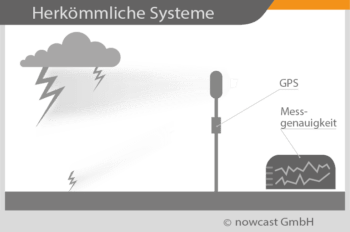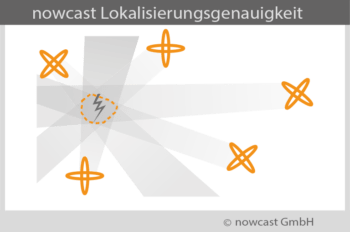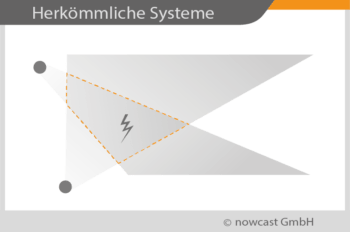The unique LINET design
Patented 3D locating
The patented low-frequency 3D locating antenna processes all signals from intra-cloud and cloud-to-ground strokes loss-free.

LINET not only differentiates between intra-cloud and cloud-to-ground flashes, but also determines the height of intra-cloud flashes. nowcast has succeeded in perfecting the Time-of-Arrival (TOA) algorithm and modeled all relevant environmental influences affecting the electromagnetic radiation from the flash along its path to the sensor. This enables determining the height using the TOA method. All of the detected electromagnetic signals can be used to locate the flash because no lightning signal needs to be discarded because it is difficult to identify the wave form.
The localisation of intra-cloud strokes is performed using the low-frequency spectrum (LF/VLF). This innovative method, developed and patented by nowcast, makes it possible to locate intra-cloud strokes with detectors spaced up to around 250 km apart. Only the precision and sensitivity of the overall system enable this unique 3D locating.
When compared with highly specialized research systems (VHF-systems with a very dense sensor network), LINET altitude data for intra-cloud flashes have proven completely consistent with results from reference systems.*
*Source: Stolzenburg at al., 2010

Conventional wide-area lightning detection systems (LF/VLF) cannot determine the altitude of intra-cloud strokes. To distinguish between intra-cloud and cloud-to-ground strokes, these methods apply waveform discrimination, which discards a substantial amount of data readings that do not fit the pattern of the method. The discarded strokes are not included in the output.
High-frequency systems (HF/VHF) are capable of determining the altitude of strokes to some extent. However, due to the nature of high-frequency signals, they require a very dense sensor network – resulting in higher installation costs – and are also impacted by interference effects in the high-frequency spectrum.
Unparalleled detection efficiency
Thanks to LINET’s ability to detect even very weak strokes, it achieves outstanding detection efficiency for cloud-to-ground and intra-cloud strokes.
 High LINET sensitivity enables the detection of even the weakest strokes. As a result, LINET detects a representative sample of intra-cloud as well as weak cloud-to-ground lightning strokes that cannot be measured by other systems.
High LINET sensitivity enables the detection of even the weakest strokes. As a result, LINET detects a representative sample of intra-cloud as well as weak cloud-to-ground lightning strokes that cannot be measured by other systems.In various research initiatives, LINET correctly captured and located ground strokes weaker than 4 kA that other systems failed to detect. Using visual records from cameras, the flashes in question were clearly identified as cloud-to-ground strokes.*
*Source: Stolzenburg at al., 2010

Due to their less efficient overall design, conventional lightning measurement systems detect weak strokes very poorly or not at all. However, it has been demonstrated that weak cloud-to-ground strokes do indeed exist – and that they can cause major damage. Based on the latest findings, the percentage of weak cloud-to-ground strokes is much higher than previously believed.
For a truly representative detection of intra-cloud strokes, the measurement of weak lightning signals is indispensable. The vast majority of intra-cloud strokes show peak currents below 6 kA.
Unparalleled location accuracy
The high degree of detection efficiency generally allows for the locating of strokes using at least five sensors – the essential pre-requisite for unmatched location accuracy and minimal scattering.

The research work performed by nowcast has included many experiments with different locating methods. It was demonstrated, that the direction finding method, which is possible with as few as two sensors, leads to unacceptable numbers of inaccurate findings. In contrast, with the aid of various optimizations, nowcast has succeeded in perfecting the Time-of-Arrival (TOA) method to point the location of strokes with a statistical accuracy of 75 meters (mean value, low scattering).
The precise measurements result in accurate, true-to-nature representations of the actual storm situations. In addition to a reliable database for the analysis of lightning-induced damage, the method also makes Cell Tracking and Nowcasting possible.
Fine-tuning of a network after installation is very important. Once the first thunderstorms have passed, a comparison of selected cloud-to-ground strokes to towers or other tall, exposed objects like windmills help to adjust network parameters in order to achieve the best possible detection accuracy.

Conventional lightning measurement systems often use two-sensor direction finding to locate weaker strokes that would otherwise go undetected. This approach entails large errors of up to several kilometers. Such poor readings not only create an inaccurate picture of the storm situation, but also result in unreliable data on strokes that cause damage.
Without direction finding, however, this measurement technique would result in the substantial loss of measured strokes.

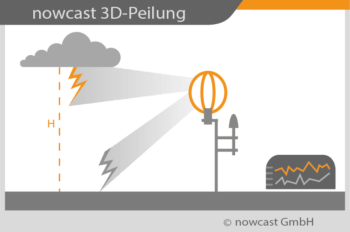
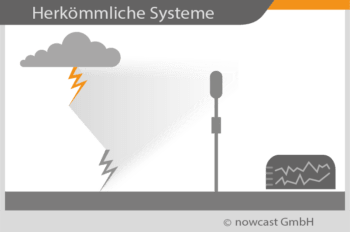
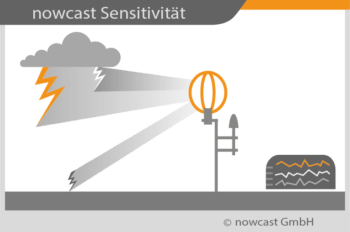 High LINET sensitivity enables the detection of even the weakest strokes. As a result, LINET detects a representative sample of intra-cloud as well as weak cloud-to-ground lightning strokes that cannot be measured by other systems.
High LINET sensitivity enables the detection of even the weakest strokes. As a result, LINET detects a representative sample of intra-cloud as well as weak cloud-to-ground lightning strokes that cannot be measured by other systems.